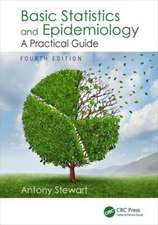The Easy Guide to OSCEs for Final Year Medical Students, Second Edition: MasterPass
Autor Nazmul Akunjee, Muhammed Akunjee, Dominic Pimenta, Dilsan Yilmazen Limba Engleză Paperback – feb 2005
The Easy Guide to OSCEs for Final Year Medical Students covers, in a self-assessment format, over 99 sample OSCE stations including the standard history, examination and general skills stations. This edition includes additional commonly examined cases and instruction on how to interpret a paper.
With newly created colour illustrations and clinical photographs, the clear layout and easy-to-read style prepares students for the examination environment and focuses on the specific areas and responses examiners look for.
The step-by-step guide provided for each OSCE station includes techniques on how to pass, what to say, what to ask for and what to do. It is an invaluable guide to all those preparing for the OSCEs.
Din seria MasterPass
- 5%
 Preț: 273.01 lei
Preț: 273.01 lei - 5%
 Preț: 245.29 lei
Preț: 245.29 lei - 5%
 Preț: 393.39 lei
Preț: 393.39 lei - 5%
 Preț: 315.49 lei
Preț: 315.49 lei - 5%
 Preț: 296.08 lei
Preț: 296.08 lei - 5%
 Preț: 346.24 lei
Preț: 346.24 lei - 5%
 Preț: 359.94 lei
Preț: 359.94 lei - 5%
 Preț: 277.64 lei
Preț: 277.64 lei - 5%
 Preț: 401.22 lei
Preț: 401.22 lei - 5%
 Preț: 349.24 lei
Preț: 349.24 lei - 5%
 Preț: 330.95 lei
Preț: 330.95 lei - 5%
 Preț: 266.30 lei
Preț: 266.30 lei - 5%
 Preț: 318.58 lei
Preț: 318.58 lei - 5%
 Preț: 257.22 lei
Preț: 257.22 lei - 5%
 Preț: 240.27 lei
Preț: 240.27 lei -
 Preț: 336.41 lei
Preț: 336.41 lei - 5%
 Preț: 422.24 lei
Preț: 422.24 lei - 5%
 Preț: 287.33 lei
Preț: 287.33 lei -
 Preț: 244.68 lei
Preț: 244.68 lei - 5%
 Preț: 388.38 lei
Preț: 388.38 lei - 5%
 Preț: 318.09 lei
Preț: 318.09 lei - 5%
 Preț: 340.87 lei
Preț: 340.87 lei - 5%
 Preț: 266.68 lei
Preț: 266.68 lei - 5%
 Preț: 288.24 lei
Preț: 288.24 lei - 5%
 Preț: 211.88 lei
Preț: 211.88 lei - 5%
 Preț: 296.12 lei
Preț: 296.12 lei - 5%
 Preț: 482.31 lei
Preț: 482.31 lei - 5%
 Preț: 361.64 lei
Preț: 361.64 lei - 5%
 Preț: 219.33 lei
Preț: 219.33 lei - 5%
 Preț: 346.44 lei
Preț: 346.44 lei - 5%
 Preț: 331.92 lei
Preț: 331.92 lei - 5%
 Preț: 266.07 lei
Preț: 266.07 lei - 5%
 Preț: 364.76 lei
Preț: 364.76 lei - 5%
 Preț: 344.04 lei
Preț: 344.04 lei - 5%
 Preț: 375.32 lei
Preț: 375.32 lei - 5%
 Preț: 361.55 lei
Preț: 361.55 lei - 5%
 Preț: 390.59 lei
Preț: 390.59 lei - 5%
 Preț: 317.49 lei
Preț: 317.49 lei - 8%
 Preț: 424.47 lei
Preț: 424.47 lei - 5%
 Preț: 316.59 lei
Preț: 316.59 lei - 5%
 Preț: 422.64 lei
Preț: 422.64 lei - 5%
 Preț: 236.46 lei
Preț: 236.46 lei - 5%
 Preț: 369.72 lei
Preț: 369.72 lei - 5%
 Preț: 182.04 lei
Preț: 182.04 lei - 5%
 Preț: 293.92 lei
Preț: 293.92 lei - 5%
 Preț: 439.72 lei
Preț: 439.72 lei - 5%
 Preț: 272.24 lei
Preț: 272.24 lei - 5%
 Preț: 267.21 lei
Preț: 267.21 lei - 5%
 Preț: 290.51 lei
Preț: 290.51 lei
Preț: 300.52 lei
Preț vechi: 316.33 lei
-5% Nou
Puncte Express: 451
Preț estimativ în valută:
57.51€ • 59.92$ • 47.82£
57.51€ • 59.92$ • 47.82£
Carte disponibilă
Livrare economică 20 ianuarie-03 februarie 25
Livrare express 04-10 ianuarie 25 pentru 48.58 lei
Preluare comenzi: 021 569.72.76
Specificații
ISBN-13: 9781910227084
ISBN-10: 1910227080
Pagini: 370
Ilustrații: illustrations
Dimensiuni: 178 x 254 x 23 mm
Greutate: 0.92 kg
Ediția:Revised
Editura: CRC Press
Colecția CRC Press
Seria MasterPass
Locul publicării:Boca Raton, United States
ISBN-10: 1910227080
Pagini: 370
Ilustrații: illustrations
Dimensiuni: 178 x 254 x 23 mm
Greutate: 0.92 kg
Ediția:Revised
Editura: CRC Press
Colecția CRC Press
Seria MasterPass
Locul publicării:Boca Raton, United States
Public țintă
Professional Practice & DevelopmentRecenzii
"Refreshing and highly relevant. All clinical knowledge has been thoroughly researched and is in line with current evidence and guidelines. This is an excellent book that will reward all those who study and apply it in the all-important finals!"
—Edward Lamuren
—Edward Lamuren
Cuprins
PREFACE, MARKING SCHEMES, HISTORY TAKING CHAPTER 1.1 General medical history CHAPTER 1.2 Rheumatological history CHAPTER 1.3 Chest pain CHAPTER 1.4 Breathlessness CHAPTER 1.5 Loss of consciousness CHAPTER 1.6 Headaches CHAPTER 1.7 General surgical history CHAPTER 1.8 Urological history CHAPTER 1.9 Abdominal pain CHAPTER 1 .10 Breast lump EXAMINATIONS CHAPTER 2.1 Cardiovascular CHAPTER 2.2 Respiratory CHAPTER 2.3 Abdomen CHAPTER 2.4 Cranial nerve examination CHAPTER 2.5 Upper limb neurological exam CHAPTER 2.6 Lower limb neurological examination CHAPTER 2.7 Cerebellar exam CHAPTER 2.8 Speech CHAPTER 2.9 Eye CHAPTER 2.10 Ear CHAPTER 2 .11 Nose CHAPTER 2.12 Arterial circulation 1CHAPTER 2.13 Venous circulation 1CHAPTER 2.14 Ulcers CHAPTER 2 .15 Neck lump CHAPTER 2 .16 Lymphatic system examination CHAPTER 2.17 Thyroid CHAPTER 2.18 Breast CHAPTER 2.19 Rectal CHAPTER 2.20 Inguinal scrotal CHAPTER 2.21 Gals (gait, arms, legs, spine screen) CLINICAL SKILLS CHAPTER 3.1 Hand washing CHAPTER 3.2 Venepuncture CHAPTER 3.3 Cannulation CHAPTER 3.4 IV infusion CHAPTER 3.5 Blood transfusion CHAPTER 3.6 Intravenous injection CHAPTER 3.7 Intramuscular injection CHAPTER 3.8 Male catheterisation CHAPTER 3.9 Nasogastric intubation Pat Contents - MANAGEMENT OF THE ACUTELY UNWELL PATIENT; PRESCRIBING; CHAPTER 5.7 Hyperkalaemia COMMUNICATION SKILLS; EVIDENCE APPRAISAL
Descriere
The final year Objective Structured Clinical Examinations (OSCEs) test a broad range of practical skills, knowledge, examination technique and communication abilities, and can be a daunting prospect. The Easy Guide to OSCEs for Final Year Medical Students covers, in a self-assessment format, over 99 sample OSCE stations including the standard history, examination and general skills stations. This edition includes additional commonly examined cases and instruction on how to interpret a paper. With newly created colour illustrations and clinical photographs, the clear layout and easy-to-read style prepares students for the examination environment and focuses on the specific areas and responses examiners look for.








